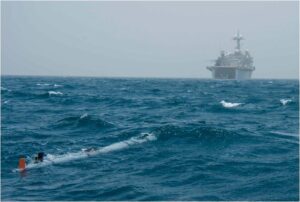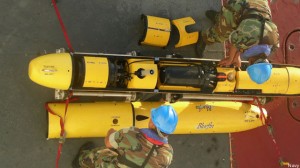
A Navy unmanned underwater vehicle approaches the USS Ponce
Think it’s hard to find a place to charge your smartphone at the airport? Try finding a power outlet in the ocean.
Imagine you’re a robotic Navy mini-sub whose batteries are running low after a long mission monitoring, say, traffic around Chinese artificial islands in the South Pacific. Currently, you’d have to recharge at a land base or a surface ship. The former keeps you close to friendly shores while the latter gives away your presence. But if Navy program manager Mike Wardlaw makes it work, sometime in the early 2020s the Navy will start deploying unmanned, underwater pods where robots can recharge undetected — and securely upload the intelligence they’ve gathered to Navy networks.
“It’s a 7-11 underwater,” for robots, said Wardlaw, the program manager for what the Office of Naval Research calls FDECO. (That stands for “Forward-Deployed Energy & Communications Outpost,” a clunker of a term we promise not to use again). Like an old-time travelling salesman stopping to get some gas and use a payphone, unmanned underwater vehicles (UUVs) can dock, recharge, upload data and download new orders, and then be on their way.
“The big limitations on UUVs are power and communications,” said Paul Scharre, who runs the futuristic 20YY Warfare Initiative at the Center for a New American Security. FDECO intends to help with both.
Power is the most basic problem. Full-sized submarines are powered by diesel engines or nuclear reactors, but robotic mini-subs rely on batteries, which carry much less power per pound of weight (a concept called “energy density”). So a UUV that goes a long way or stays on station a long time needs to be big — which means more expensive and easier to detect.
“How would you design a car to drive all the way across the country?” Wardlaw asked. “You can design (a) car that has a tanker behind it, and it’s carrying all the fuel that it needs, or you can put some gas stations along the way…. What I’m doing is, I’m creating the 7-11s or the gas stations along the way.”
Just as critical is the communications aspect. Conventional radio can’t transmit underwater. Very low-frequency radio and sound waves carry long distances, but with very low bandwidth, explained former Navy undersecretary Bob Martinage. Newer technologies such as communications lasers and LEDs have high bandwidth but very short range. With an underwater hub like FDECO, Martinage said, you get the best of both worlds. The UUV uses a short-range, high-bandwidth method to upload all its data to the FDECO while they’re recharging. Then, while waiting for the next UUV to come in, the FDECO transmits the data over a long-range, low-bandwidth method.
These techniques could transmit data “several hundred miles,” said Bryan Clark, a retired Navy submariner who now works with Martinage at the Center for Strategic and Budgetary Assessments. “(FDECO) enables us to extend the undersea communications/power network farther than could be done with just fiber (optic cable) on the sea floor.”
Where would such extended underwater reach be useful? It probably wouldn’t add much value in the narrow waters of the Persian Gulf, where ranges are short and US or allied bases close at hand, said Martinage. It would be more useful in open oceans like the North Atlantic — an area of increasing concern with the rise of Russian revanchism — and it would be most useful in the Pacific.
In fact, yesterday’s incident in the South China Sea shows the potential value of FDECO. A Navy P-8 Poseidon was reconnoitering Chinese-built islets when the Chinese hailed it on the radio and ordered it to leave “their” airspace. (Under international law, building an artificial island does not actually convey any territorial rights to the surrounding seas or waters). Nothing else happened, but in the past Chinese aircraft have intercepted US spy planes and come dangerously close. The worst incident was a 2001 collision off Hainan Island that ended up with the US aircrew in Chinese captivity for 11 days.
Unmanned systems, by definition, don’t have crew to capture. Unmanned underwater vessels are also smaller and harder to detect than manned submarines, so the adversary is less likely to find them in the first place. Admittedly, submersibles can’t carry the same sensors as an aircraft, and by their stealthy nature they can’t make a political statement by the presence in disputed areas. But UUVs can collect data without being seen and without putting human life at risk. What’s more, shifts of UUVs can keep up round-the-clock surveillance that aircraft couldn’t with a FDECO node nearby.
“You could keep this continuous swarm of UUVs wherever you wanted to put them… basically indefinitely, as long as you’re rotating (some) out periodically for mechanical issues,” Scharre said. “If you had the ability for them to go out, perform a short reconnaissance mission — say several days — and come back, dock, recharge, transmit that data, and then get issued new orders and go back out, that would be a pretty powerful capability.”
Even backed by FDECO, however, UUVs aren’t winning any wars on their own. Indeed, for now, they’re limited to intelligence, surveillance, and reconnaissance missions. Arming current UUVs is a problem both because of their small size and because they will often be out of communication with any human overseer. Most of them also lack the speed to hunt down surface ships over wide areas, Martinage said.
FDECO-backed UUVs would be best suited to long-term surveillance and other operations where persistence mattered more than speed, such as mine-clearing. How about a robotic blockade? “Blockade may be difficult with just UUVs until we work out how to control them in real time for offensive operations,” Clark told me. “They could detect and track ships, however, to support other platforms doing a blockade.”
“This would be part of an overall system,” Martinage added. The era of lone-wolf submarines is giving away to underwater networks of manned subs, UUVs combined with seafloor infrastructure such as hidden missile launchers — all connected to each other and to the rest of the force on the surface of the water, in the air, in space, and on land. Indeed, the FDECOs would need Navy surface ships — or secretly contracted civilian vessels — to secretly drop them in the right spot in the water in the first place.
“Lots is going on in undersea warfare… new submarines, new UUVs… but they all have to work together, and there has to be an undersea network,” Martinage said. “FDECO has to be part of that network.”

Building FDECO
So how will the Navy actually build these underwater charging stations and communications relays? Technically, the FDECO program hasn’t even started.
“The program officially starts in FY 16,” Wardlaw told me. “In (fiscal) 15 we’ve been able to get some jumpstart funds to start the initial analysis, the conversations with the fleet to find out what is it that they think they would need… We’ve started a whole series of studies in 15 to make an assessment of what we should try to shoot for in the actual design.”
Run by the Office of Naval Research under a special process called an Innovative Naval Prototype (INP), the FDECO program will receive “tens of millions per year,” Wardlaw said, declining to offer a specific figure. The plan is to conduct two major experiments a year, starting in 2016, and two larger “demonstrations,” he said, “one at end of 17 and one at end of 19.”
The program’s had an industry day this past Monday, when they brought in companies that work with a host of existing UUV programs and asked them what they needed FDECO to do. “We’re going to focus on the vehicles that are currently in the fleet right now first to make sure we can support those,” Wardlaw said, “but also do it with a clear understanding of what’s coming down the pike that we might need to support in the future.
“It’s complicated,” Wardlaw said. “For the most part, each vendor has their own unique connections and procedures for recharging their vehicle.” That makes it a challenge to build a charging station that’s “platform-agnostic” and can fit a wide range of UUVs, let alone all of them. “We don’t have to get to 100 percent,” he said, as long as they build a flexible FDECO that can add new connections over time. “We’re very much focused on the interfaces.”
“These vehicles are not cheap, (and) any time you do any modifications it costs a significant amount of money,” Wardlaw said. The goal is to minimize the modifications any specific UUV requires to be compatible with FDECO. “It’s probably not because for no modifications to be (required),” he said. “Every vehicle manufacturer has their own interface.”
Wardlaw is focusing on interfaces and components first, and will then integrate it all into a single system later. So he doesn’t know what FDECO will look like — yet. In fact, he expects it to look different in different places and on different missions. One optimized for the Mediterranean, for example, might be smaller and have less powerful communications equipment than one intended for the vastness of the Pacific.
FDECO won’t just be flexible. Wardlaw also wants it to be smart. “You drop a node like this in the vicinity of where the vehicles (UUVs) are going to operate, you give the vehicles and the node a mission objective, and between the node and the vehicle, they execute the mission autonomously,” he said. As each UUV comes back to the FDECO node, the computers on each will share tactical data and match it against the missions assigned by their human masters. Because it receives data from multiple UUVs, the FDECO will be able to coordinate their operations.
For example, “if you want to use a low-frequency sonar to search a large area, that low frequency sonar may not be the best approach for doing high resolution imaging,” Wardlaw said. “If (a UUV) finds something with the low-frequency sonar, it can now communicate that through the node to another vehicle that has a high-frequency sonar that can follow up on it — and all of this can be done completely autonomously.”
This isn’t autonomy of the scale of Skynet, formulating strategic goals and war plans without human intervention. It’s not even the autonomy of a Terminator, executing a specific tactical mission unaided. Instead, it’s simply one computer allocating tasks to others on a very technical, nitty-gritty level. Even so, however, a FDECO node orchestrating the actions of a swarm of UUVs would be an important step forward, for good or ill, towards war-making without humans.
Shipbuilder Austal USA names Michelle Kruger as new president
Kruger had been serving as interim president since former chief Rusty Murdaugh resigned last spring.



























